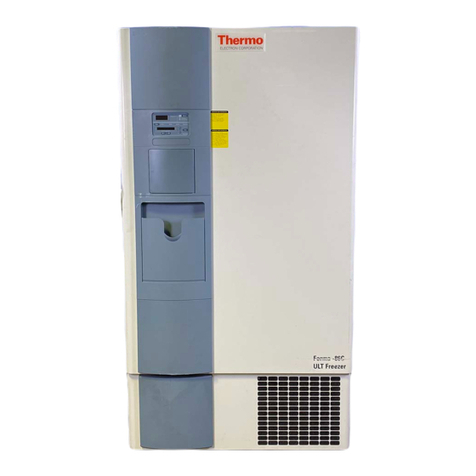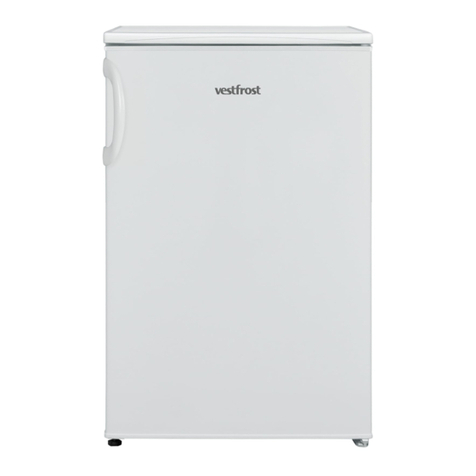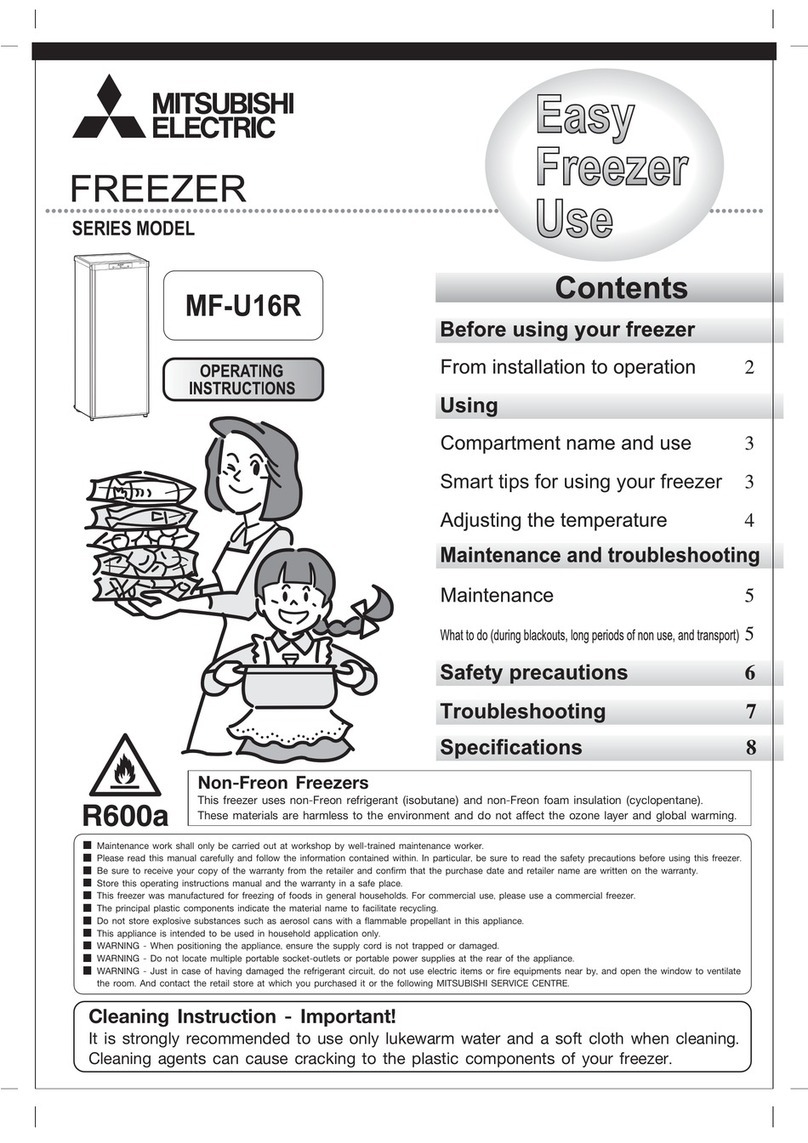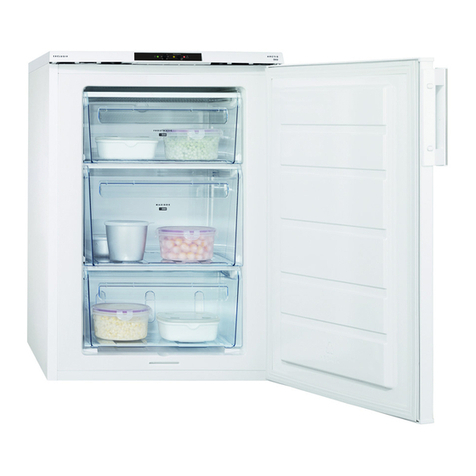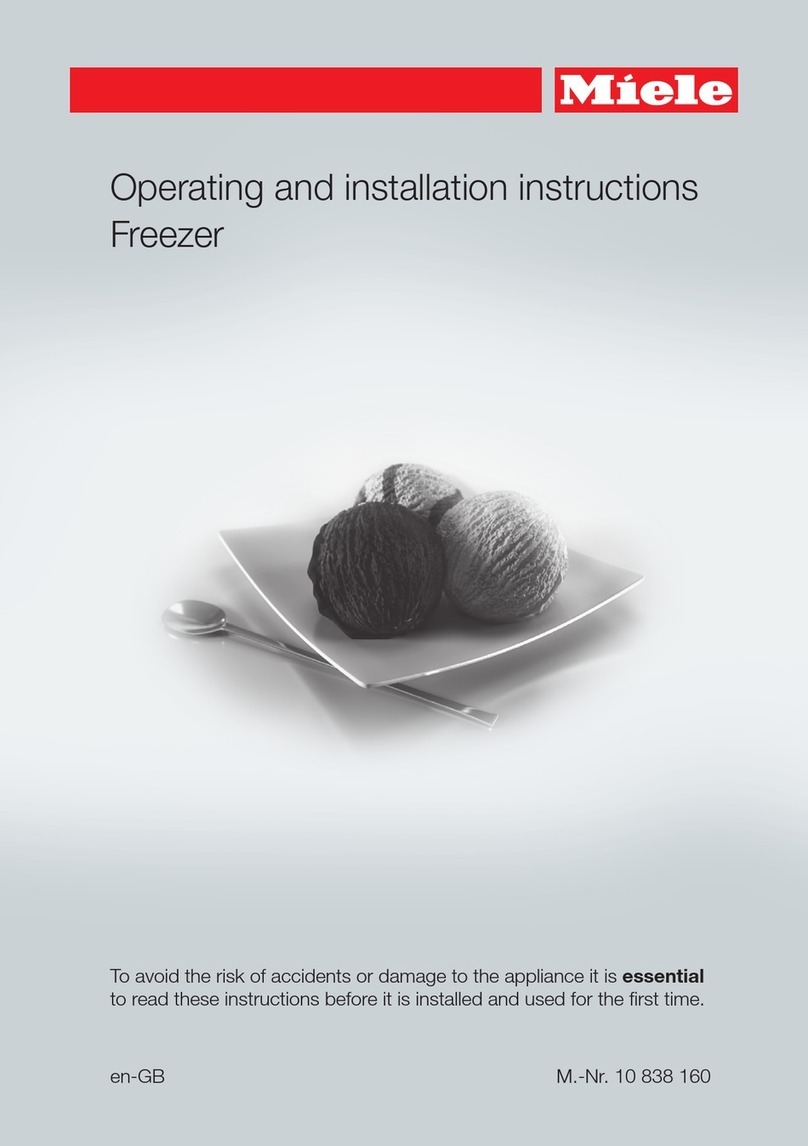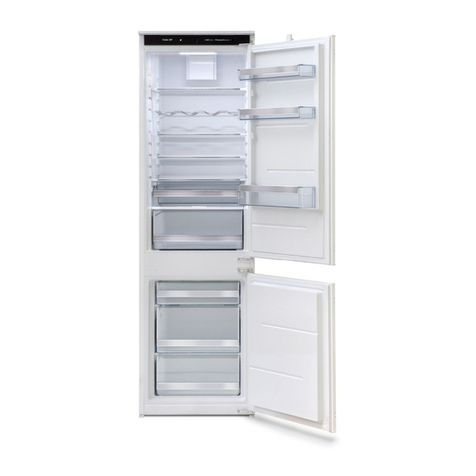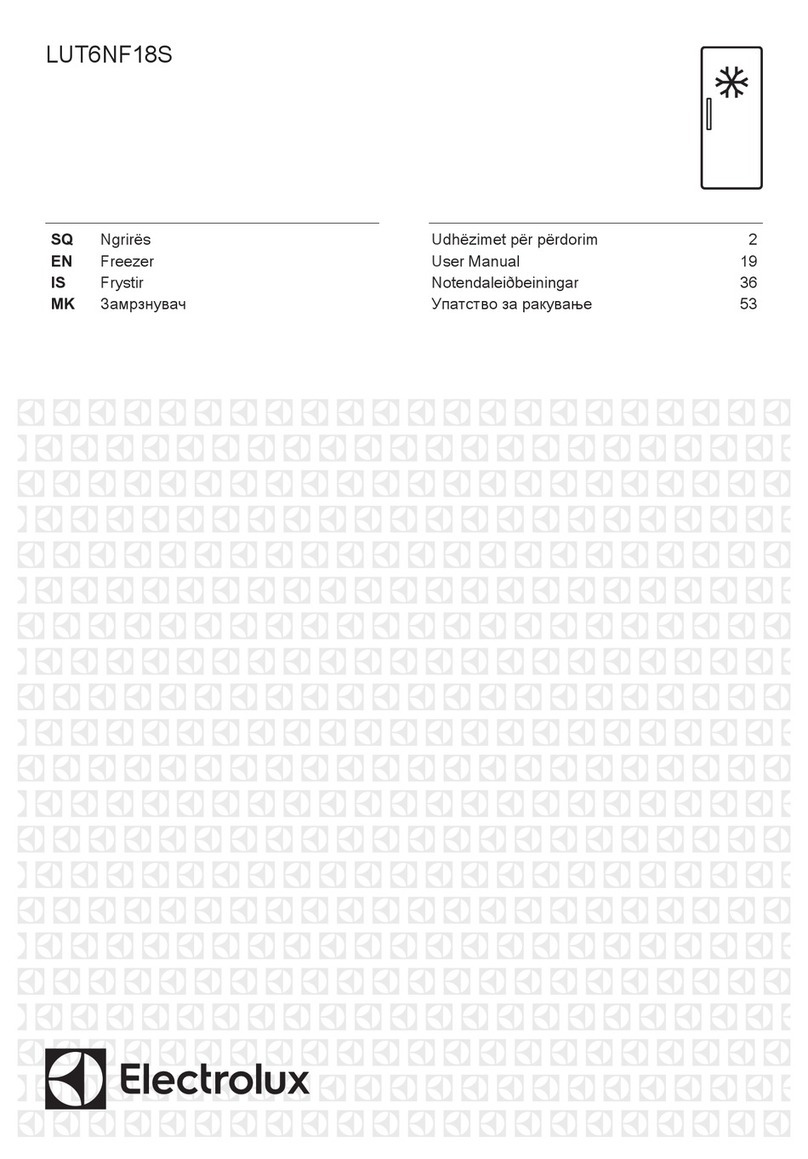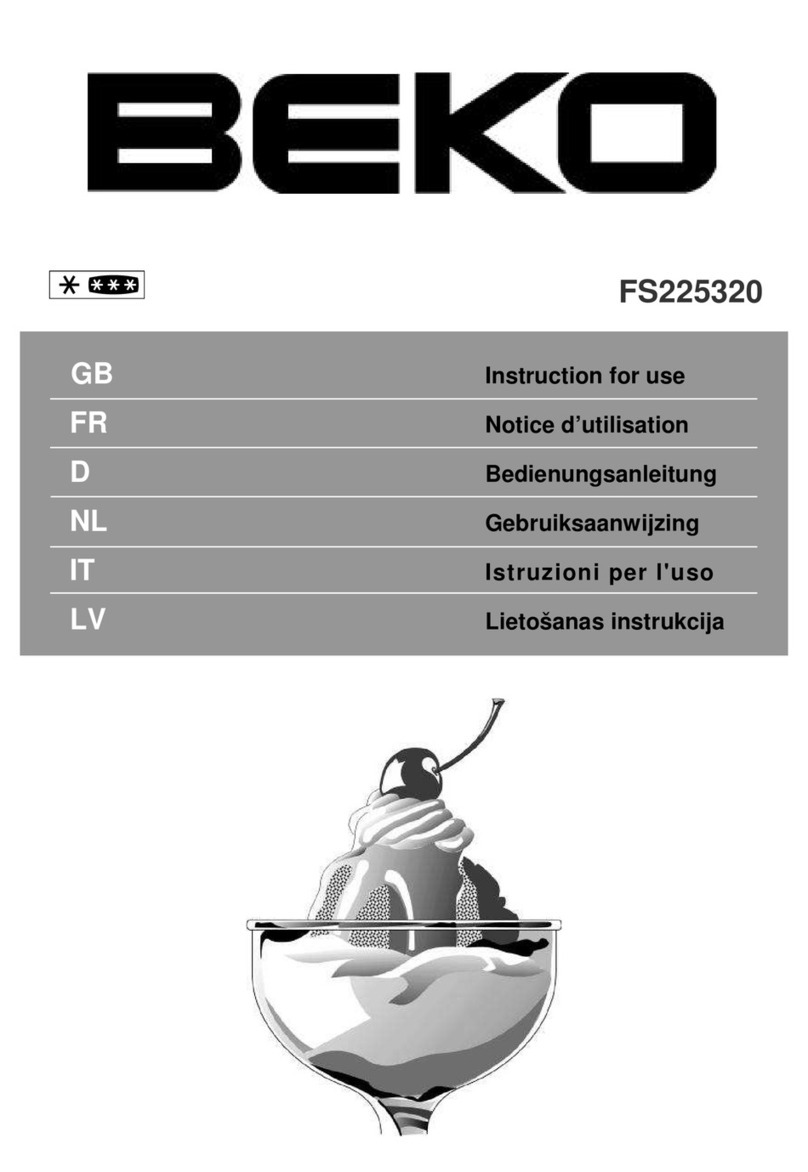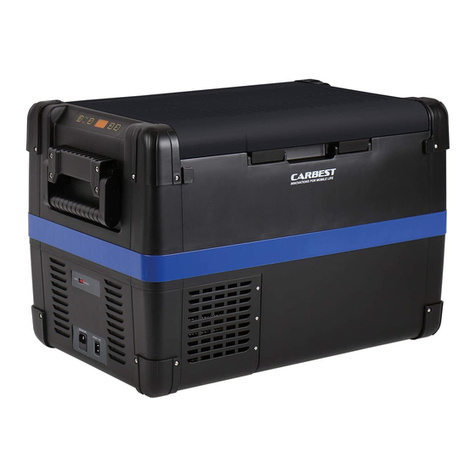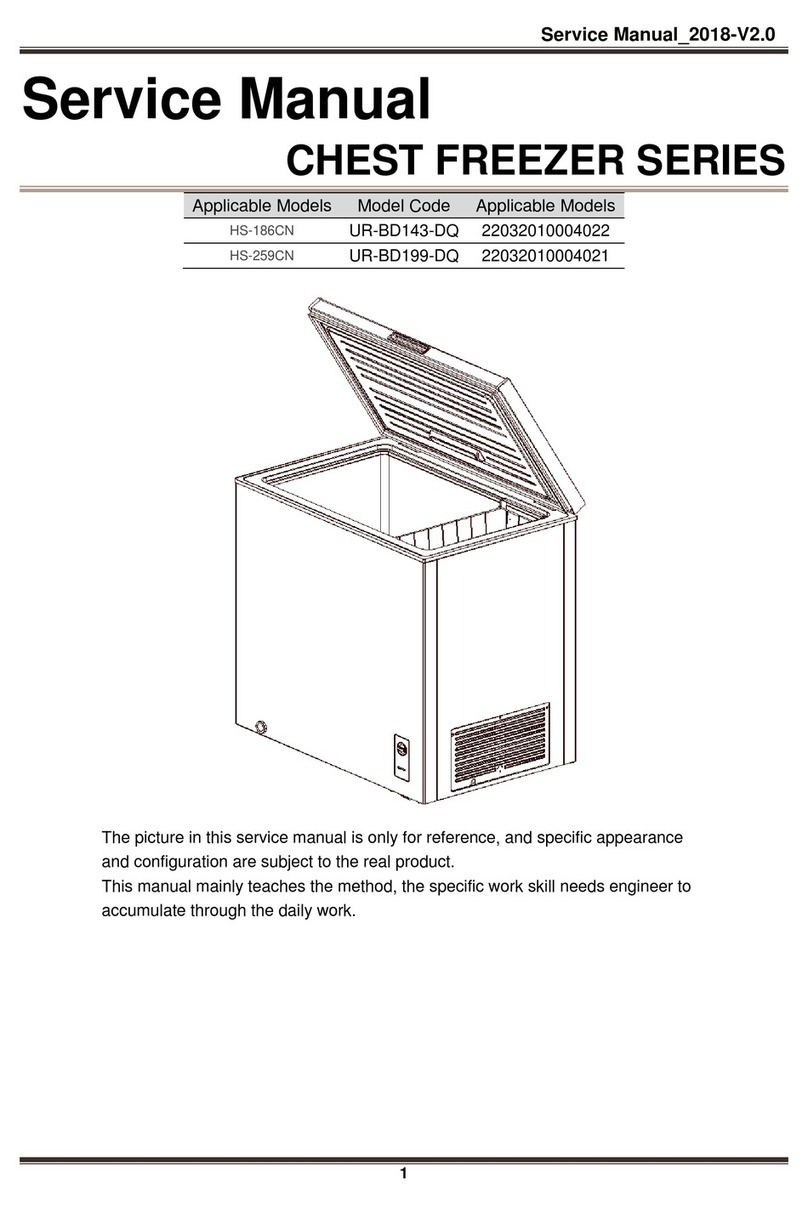Thermo Electron 900 Series Operating instructions

900 Series
Forma -86C ULT Freezer
Operating and Maintenance Manual
Manual No: 7010902 Rev. 8

Model 900 Series _______________________________________________________________________________
i
Read This Instruction Manual.
Failure to read, understand and follow the instructions in
this manual may result in damage to the unit, injury to operat-
ing personnel, and poor equipment performance.
CAUTION! All internal adjustments and maintenance must
be performed by qualified service personnel.
The material in this manual is for information purposes only. The
contents and the product it describes are subject to change with-
out notice. Thermo Electron Corporation makes no representa-
tions or warranties with respect to this manual. In no event shall
Thermo be held liable for any damages, direct or incidental, aris-
ing out of or related to the use of this manual.
MANUAL NUMBER 7010902
8 22676 5/26/05 Changed control panel alarm indicators aks
7 22562 3/3/05 Modified software to allow alarms within 5C of set point aks
6 22518 2/3/05 Changed battery bracket assembly aks
5 22362 9/10/04 Changed micro board aks
4 22136 5/5/04 Revised electrical schematics, additional vacuum relief information aks
3 22216/22217/22179 3/12/04 Added models 956 and 990/PM updates/updated schematics aks
2 21886 9/22/03 Vacuum relief port aks
-- 21800 9/9/03 Revised refrigeration schematics aks
1 21795 8/11/03 Revised BUS operation instructions aks
-- 21396/21425 6/19/03 Revised parts drawings aks
-- 21605 5/9/03 Wrong power alarm modifications aks
-- 21526 5/9/03 Solenoid valve mounting bracket aks
0 FR-1698 5/9/03 Release 2 aks
REV ECR/ECN DATE DESCRIPTION By
Model Capacity in
Cubic Feet Voltage
902 13 230
903 13 120
904 17 120
905 17 230
906 23 230
907 28 230
956 23 120
Double Door Units
990 23 120
991 13 230
992 13 120
993 17 120
994 17 230
995 23 230

Model 900 Series _________________________________________________________________________Warnings
ii
Important operating and/or maintenance instructions. Read the accompanying text carefully.
Potential electrical hazards. Only qualified persons should perform procedures associated with this symbol.
Hot surface(s) present which may cause burns to unprotected skin or to materials which may be damaged by elevated
temperatures
Extreme temperature hazards, hot or cold. Use special handling equipment or wear special, protective clothing.
√ Always use the proper protective equipment (clothing, gloves, goggles, etc.)
√ Always dissipate extreme cold or heat and wear protective clothing.
√ Always follow good hygiene practices.
√ Each individual is responsible for his or her own safety.

Model 900 Series ___________________________________________________________________________Service
iii

Model 900 Series __________________________________________________________________Table of Contents
iv
Table of Contents
Section 1 - Installation and Start-up . . . . . . . . . . . . . . .1 - 1
1.1 Freezer Components . . . . . . . . . . . . . . . . . . . . . . . . .1 - 1
1.2 Control Panel Keys, Displays and Indicators . . . . . .1 - 2
1.3 Operation of the Keypad . . . . . . . . . . . . . . . . . . . . . .1 - 3
1.4 Installing the Freezer . . . . . . . . . . . . . . . . . . . . . . . . .1 - 3
a. Choosing the Location . . . . . . . . . . . . . . . . . . . . .1 - 3
b. Installing the Wall Bumpers . . . . . . . . . . . . . . . . .1 - 3
c. Installing the Shelves . . . . . . . . . . . . . . . . . . . . . .1 - 3
d. Remote Alarm Contacts . . . . . . . . . . . . . . . . . . . . .1 - 3
e. Attaching the Power Cord . . . . . . . . . . . . . . . . . . .1 - 4
f. Connecting the Unit to Electrical Power . . . . . . . .1 - 4
1.6 Freezer Start-Up . . . . . . . . . . . . . . . . . . . . . . . . . . . . .1 - 4
a. Setting the Operating Temperature . . . . . . . . . . . .1 - 4
b. Setting the High Temperature Alarm . . . . . . . . . . .1 - 4
c. Setting the Low Temperature Alarm . . . . . . . . . . .1 - 5
1.7 Run Mode . . . . . . . . . . . . . . . . . . . . . . . . . . . . . . . . . .1 - 5
Section 2 - Calibrate . . . . . . . . . . . . . . . . . . . . . . . . . . . .2 - 1
2.1 Calibrate Mode . . . . . . . . . . . . . . . . . . . . . . . . . . . . . .2 - 1
a. Calibrating the Control Probe . . . . . . . . . . . . . . . .2 - 1
Section 3 - Alarms . . . . . . . . . . . . . . . . . . . . . . . . . . . . . .3 - 1
3.1 Alarms . . . . . . . . . . . . . . . . . . . . . . . . . . . . . . . . . . . .3 - 1
3.2 Probe Failure Alarm . . . . . . . . . . . . . . . . . . . . . . . . . .3 - 1
Section 4 - Maintenance . . . . . . . . . . . . . . . . . . . . . . . . .4 - 1
4.1 Cleaning the Cabinet Exterior . . . . . . . . . . . . . . . . . .4 - 1
4.2 Cleaning the Air Filter . . . . . . . . . . . . . . . . . . . . . . . .4 - 1
4.3 Cleaning the Condenser . . . . . . . . . . . . . . . . . . . . . . .4 - 1
a. Cleaning the Water-cooled Condenser . . . . . . . . . .4 - 1
4.4 Defrosting the Chamber . . . . . . . . . . . . . . . . . . . . . . .4 - 1
4.5 Cleaning the Door Gasket . . . . . . . . . . . . . . . . . . . . .4 - 2
4.6 Cleaning the Vacuum Relief Port . . . . . . . . . . . . . . . .4 - 2
4.7 Replacing the Battery(s) . . . . . . . . . . . . . . . . . . . . . .4 - 4
4.8 Preparing the Unit for Storage . . . . . . . . . . . . . . . . . .4 - 4
Preventive Maintenance . . . . . . . . . . . . . . . . . . . . . . . . . .4 - 5
Section 5 - Factory Options . . . . . . . . . . . . . . . . . . . . . .5 - 1
5.1 BUS (Back Up System) . . . . . . . . . . . . . . . . . . . . . . .5 - 1
a. Installing the vent stack, solenoid and injection
assembly . . . . . . . . . . . . . . . . . . . . . . . . . . . . . . . .5 - 1
b. Installing the Temperature Probe . . . . . . . . . . . . . .5 - 2
c. Connecting the probe/solenoid harness . . . . . . . . .5 - 2
d. BUS Control Panel . . . . . . . . . . . . . . . . . . . . . . . .5 - 3
e. Configuring the Optional BUS . . . . . . . . . . . . . . .5 - 3
f. Setting the Optional BUS Set Point . . . . . . . . . . . .5 - 3
g. Cleaning the Vent Stack . . . . . . . . . . . . . . . . . . . . .5 - 3
h. Disconnecting the fitting assembly and
transfer hose . . . . . . . . . . . . . . . . . . . . . . . . . . . . .5 - 3
5.2 Chart Recorder . . . . . . . . . . . . . . . . . . . . . . . . . . . . . .5 - 4
a. Installing the chart paper . . . . . . . . . . . . . . . . . . .5 - 4
b. Recorder Calibration . . . . . . . . . . . . . . . . . . . . . . .5 - 4
5.3 Datalogger . . . . . . . . . . . . . . . . . . . . . . . . . . . . . . . . .5 - 5
5.4 Water-Cooled condenser . . . . . . . . . . . . . . . . . . . . . . .5 - 5
5.5 Five Inner Door Option . . . . . . . . . . . . . . . . . . . . . . .5 - 5
Section 6 - Specifications . . . . . . . . . . . . . . . . . . . . . . . .6 - 1
Section 7 - Spare Parts . . . . . . . . . . . . . . . . . . . . . . . . . .7 - 1
Section 8 - Refrigeration Schematics . . . . . . . . . . . . . .8 - 1
Section 9 - Electrical Schematics . . . . . . . . . . . . . . . . .9 - 1
Section 10 - Warranty . . . . . . . . . . . . . . . . . . . . . . . . .10 - 1
Appendix A - Handling Liquid Nitrogen . . . . . . . . . . . .A - 1
Appendix B - Handling Liquid CO2. . . . . . . . . . . . . . .B - 1
First Aid . . . . . . . . . . . . . . . . . . . . . . . . . . . . . . . . . . . . . .C - 1

Section 1 - Installation and Start-up
Model 900 Series ___________________________________________________________________Installation and Start-Up
1 - 1
Figure 1-1
900 Series Front
Figure 1-2
900 Series Rear
1.1 Freezer Components
Figure 1-1
• Control Panel - keypad, displays and indicators
• BUS (Optional Back Up System) panel
• Optional temperature recorder or datalogger
Figure 1-2
• Remote alarm contacts
• Power Inlet for power cord connection
• Optional BUS connections for probe and solenoid
• Power Switch (mains disconnect)
Figures 1-3 and 1-4
• Vacuum relief port - pressure equalization port
• Probe cover - houses control, optional recorder, datalogger,
or 1535 alarm probes
Figure 1-4
Vacuum Relief and Probe Cover Location
Figure 1-3
Chamber Probe(s)

1.2 Control Panel Keys, Displays and Indicators
(See Figure 1-6)
1. Temperature Display - Displays temperature in degrees
Celsius.
2. Mode Select Switch - Used to select Run, Set
Temperature, Set High Alarm, Set Low Alarm, Calibrate,
Backup.
3. Alarm Indicator - Light pulses on/off during an alarm
condition of the cabinet.
4. Silence - Silences the audible alarm.
5. Alarm Panel - indicates the current alarm condition.
6. Up and Down Arrows - Increases or decreases values,
toggles between choices.
7. Enter - Stores the value into memory.
Figure 1-6, Control Panel
1 - 2
Model 900 Series ____________________________________________________________Installation and Start-Up
Figure 1-5
Battery(s) location and Switch
Figure 1-5
• Battery mounting bracket(s)
• Battery power switch (freezer and BUS)
• Freezer battery
• Optional BUS battery
• Freezer filter location

1.3 Operation of the Keypad
The 900 Series freezer has five basic modes
which allow freezer setup and operation. Press the
Mode key to scroll through the mode selections.
Up Arrow: Increases or toggles the parameter
value.
Enter: Must press Enter key to save to memo-
ry all changed values.
Down Arrow: Decreases or toggles the param-
eter value.
Silence Key: Press to silence the audible
alarm. See Section 4 for alarm ringback times.
1.4 Installing the Freezer
To remove the freezer from the pallet, use the 7/16"
wrench to remove all the bolts securing the shipping bracket to
the pallet.
Remove the shipping bracket. Remove the ramp boards
from the pallet and place the slotted end over the ramp brackets
on the pallet. The support blocks on the ramps will be facing
down. Before moving the freezer, make sure the casters are
unlocked and moving freely. Align the caster with the ramp
boards. Use adequate personnel to roll the freezer off the pallet.
The freezer can be easily pushed to the desired approved
location, described in Section 1.4.a. If necessary, the doors and
lower front panel may be opened to move the unit through tight
openings. When the freezer is in position, set the front caster
brakes.
a. Choosing the Location
Locate the freezer on a firm, level surface in an area with
an ambient temperature between 18°C and 32°C. Provide ample
room to reach the mains disconnect switch (power switch)
located on the rear of the freezer.
b. Installing the Wall Bumpers
The parts bag, located inside the cabinet, contains the fol-
lowing parts.
Install the bolts into the pre-tapped holes on the back of the
compressor section. Install a neoprene cap on each bolt. Refer
to Figure 1-2 for the locations of the pre-tapped holes.
c. Installing the Shelves
Install the shelf clips into the shelf pilasters (front and
back) at the desired shelf level. Install the shelves in the cabinet
onto the clips.
NOTE: On units having the optional 5 inner door option, refer
to the instructions accompanying the inner door kit.
Model 900 Series ___________________________________________________________________Installation and Start-Up
1 - 3
If tipped more than 45°, allow the unit to set
upright for 24 hours before start up.
The freezer must not be moved with the product
load inside.
Quantity Stock # Description Purpose
2510016 1/4-20 x 5-1/2” Bolt Wall Bumper
2 380520 Neoprene Cap Cap Protector
For proper ventilation and airflow, a minimum
clearance of 5” at the rear and top and a clear-
ance of 8” on the side of the freezer is required.
Allow adequate space in the front of the freezer
for door opening.
Figure 1-7

d. Remote Alarm Contacts
The remote alarm provides a NO (normally open) output,
a NC (normally closed) output and COM (common). The con-
tacts will trip on a power outage, high temperature alarm or low
temperature alarm. Figure 1-8 shows the remote contacts in
alarm state.
e. Attaching the Power Cord
Insert the power cord into the power inlet module. Place
the retaining bracket (p/n 195763) over the connector. Tighten
retaining screws to secure.
f. Connecting the Unit to Electrical Power
See the serial tag on the side of the unit for electrical specifi-
cations or refer to the electrical schematics in this manual.
The freezer should be operated on a dedicated grounded
service. Check the voltage rating on the serial tag of the unit
and compare it with the outlet voltage. Then, with the power
switch turned off, plug the line cord into the wall outlet.
First, turn on the freezer power switch. Then open the
lower front door by grasping the bottom left corner. Locate the
battery switch and turn it on. See Figure 1-5. During initial
freezer start-up, the system battery may require charging and
the Low Battery indicator may illuminate.
1.6 Freezer Start-Up
With the freezer properly installed and connected to power,
system set points can be entered. The following set points can
be entered in Settings mode: Control temperature, high temper-
ature alarm set point, low temperature alarm set point, and
(optional) BUS set point. Default settings are shown in the table
below.
a. Setting the Operating Temperature
All 900 Series freezers have an operating temperature
range of -50°C to -86°C, depending on ambient temperature.
The freezer is shipped from the factory with a temperature set
point of -80°C. To change the operating temperature set point:
1. Press the Mode key until the Set Temperature indicator
lights.
2. Press the up/down arrow key until the desired tempera-
ture set point is displayed.
3. Press Enter to save the set point.
4. Press the Mode key until the Run indicator lights for
Run mode
If no keys are pressed, the freezer will automatically
return to RUN mode after 5 minutes.
Model 900 Series ___________________________________________________________________Installation and Start-Up
1 - 4
Figure 1-9
If the set point is changed and the low temperature and high
temperature alarms are set 10° from the set point, the alarm
set points will be adjusted automatically to maintain a dis-
tance of at least 10° from set point.
Control Set Point -80°C
High Temperature Alarm -70°C
Low temperature alarm -90°C
Optional BUS Set Point -60°C
Figure 1-8
Assure the battery switch is turned on. The
rechargeable batteries require 36 hours to charge
at initial start-up. A “Low Battery” alarm may
occur until the batteries are fully charged. Should
a power failure occur during the initial start-up
period, the electronics will have limited operation.

b. Setting the High Temperature Alarm
The high temperature alarm will activate an audible/visual
warning when the freezer chamber temperature has reached or
exceeded the high temperature alarm set point.
To set the high temperature alarm set point:
1. Press the Mode key until the Set High Alarm indicator
lights.
2. Press the up or down arrow key until the desired high
temperature alarm set point is displayed.
3. Press Enter to save the setting.
4. Press the Mode key until the Run indicator lights for
Run mode
If no control keys are pressed, the freezer will automatical-
ly return to RUN mode after 5 minutes.
Note: The high alarm set point must be set at least 5°C from
the control set point.
At initial start-up, the high temperature alarm is disabled
until the cabinet reaches set point or 12 hours elapse.
c. Setting the Low Temperature Alarm
The low temperature alarm will activate an audible/visual
warning when the freezer chamber temperature has reached or
decrease below the low temperature alarm set point.
To set the low temperature alarm set point:
1. Press the Mode key until the Set Low Alarm indicator
lights.
2. Press the up or down arrow key until the desired low
temperature alarm set point is displayed.
3. Press Enter to save the setting.
4. Press the Mode key until the Run indicator lights for
Run mode
If no control keys are pressed, the freezer will automatical-
ly return to RUN mode after 5 minutes.
Note: The low alarm set point must be set at least 5°C from
the control set point..
Model 900 Series ____________________________________________________________Installation and Start-Up
1 - 5
1.7 Run Mode
The Run mode is the default mode for the freezer. The run
mode will display the cabinet temperature on the temperature
display under normal operating conditions. In addition, the
Run mode allows display of the high stage heat exchange tem-
perature.
This information is scrolled by pressing the up or down
arrow keys. The display will return to the operating temperature
in 10 seconds if no keys are pressed.

Section 2 - Calibrate
2.1 Calibrate Mode
Once the freezer has stabilized, the control probe may need
to be calibrated. Calibration frequency is dependent on use,
ambient conditions and accuracy required. A good laboratory
practice would require at least an annual calibration check. On
new installations, all parameters should be checked after the
stabilization period.
Before making any calibration or adjustments to
the unit, it is imperative that all reference instru-
ments be properly calibrated.
a. Calibrating the Control Probe
Plug a type T thermocouple reader into the receptacle
located inside the lower door (see Figure 1-5). Compare the
control temperature set point to the temperature of the measur-
ing device.
1. Press the Mode key until the Calibrate indicator lights.
2. Press up/down arrow to match the display to calibrated
instrument.
3. Press Enter to store calibration.
4. Press the Mode key to return to Run mode.
Temperature Stabilization Periods
Startup - Allow 12 hours for the temperature in the cabinet to
stabilize before proceeding.
Already Operating - Allow at least 2 hours after the display
reaches set point for temperature to stabilize before proceeding.
During calibration, the temperature display will not be avail-
able.
If no keys are pressed for approximately five minutes while
in calibration mode, the system will reset to Run mode.
Model 900 Series _________________________________________________________________________Calibration
2 - 1

Section 3 - Alarms
3.1 Alarms
The Model 900 Series freezer alarms are displayed on the freezer control panel. When an alarm is active, the indicator next to
the alarm description will light and there will be an audible alarm. Press the Silence key to disable the audible alarm for the ringback
period. The visual alarm will continue until the freezer returns to a normal condition. The alarms are momentary alarms only. When
an alarm condition occurs and then returns to normal, the freezer automatically clears the alarm condition.
Model 900 Series ___________________________________________________________________________Alarms
3 - 1
All alarm delays and ringback times are ±30 seconds.
* The automatic battery test runs 12 hours after initial start-up, then every 12 hours thereafter.
3.2 Wrong Power
The Wrong Power alarm occurs when incorrect voltage is
applied to the freezer. If a 230 V freezer is connected to a 120 V
power source or a 120 V freezer is connected to a 230 V power
source, the electronics will detect that the "Wrong Power" has
been applied. Under this condition, the fans and compressors
will not turn on and an audible and visual alarm will occur. This
alarm may also occur if the battery switch is turned on prior to
applying power to the freezer. The audible and visual alarms will
remain until the freezer is connected to the correct power source.
The audible alarm cannot be silenced under this condition.
3.3 High Stage System Failure
The "high stage system failure" condition is created when
the high stage compressor and fans run for 30 minutes and are
not capable of cooling the interstage heat exchanger to the prop-
er temperature. Under this condition, the high stage compressor
and fans will turn off after 30 minutes and an audible and visual
alarm will occur. The audible alarm can be silenced and will
ring back every 15 minutes.
3.4 Probe Failure Alarm
The microprocessor in 900 series freezers continually scans
all probes including the control probe, heat exchanger probe and
condenser probe to ensure that they are operating properly.
Should an error be detected, the "Probe Failure" alarm will occur
as described in 3.1 above. If an error is detected with the control
probe, the high and low stage compressors will run continuously.
As a result, the cabinet temperature will decrease until it reaches
the lowest temperature that the refrigeration system can main-
tain. If an error is detected with the heat exchanger probe, the
freezer will cycle properly at its temperature set point using a 5
minute step start between the high and low stage compressors.
If an error is detected with the condenser probe, there is no
impact on the performance of the freezer; however, the hot con-
denser alarm may also occur. Contact the Technical Services
department (1-888-213-1790) or your local distributor.
3.5 Voltage Compensation Alarm
In addition to the alarms listed above, another condition is
detected by the controls that will result in an audible and visual
alarm. If the freezer is compensating for high or low line volt-
age, the system will measure the compensated AC voltage. If the
voltage is incorrect, the unit will stop attempting to compensate,
and the compressor will run on direct line voltage. Under this
condition, there will be a visual and audible alarm that can be
silenced with a ringback period of fifteen minutes. This alarm
condition is unlikely to occur, and as such, there is no LED
alarm indicator for this condition.
Description Delay Ringback Relay
Power Failure 1 min. 15 min. Yes
High Temperature Alarm 1 min. 15 min. Yes
Low Temperature Alarm 1 min. 15 min. Yes
Probe Failure see 3.2 1 min. 15 min. No
Door Open 1 min. 15 min. No
Wrong Power 0 min. none Yes
Low Battery* 1 min. 12 hours No
Hot Condenser 1 min. none No
High Stage Failure 0 min. 15 min. Yes

Section 4 - Maintenance
4.1 Cleaning the Cabinet Exterior
Wipe down the freezer exterior using soap and water and
a general use laboratory disinfectant. Rinse thoroughly with
clean water and dry with a soft cloth.
4.2 Cleaning the Air Filter (minimum of four times a
year)
1. Open the front lower door by grasping the bottom left
corner.
2. Locate the grille on the door. See Figure 1-5. Grasp the
middle of the grille material and gently pull out to
remove.
3. Wash the filter material using water and a mild deter-
gent.
4. Dry by pressing between two towels.
5. Install the filter back into the grille and attach the grille.
Depending upon environmental conditions, the filter may need
to be cleaned or replaced more frequently. If the filter becomes
torn or excessively dirty, a replacement can be purchased. See
the exploded parts list, Section 7, for filter part number. A filter
kit (set of 5) is also available.
4.3 Cleaning the Condenser (minimum yearly)
1. Open the front lower door by grasping the bottom left
corner. See Figure 1-5.
2. Using a vacuum cleaner, exercising care to not damage
the condenser fins, clean the condenser.
Depending upon environmental conditions, the condenser may
need to be cleaned more frequently.
a. Cleaning the Water-cooled Condenser
The water-cooled condenser can be cleaned-in-place by
using the CIP procedure. Cleaning solutions can be used,
depending on type of deposits or build-up to be removed.
Do not use liquids that are corrosive to stainless
steel or the brazing material (copper or nickel).
CIP (Clean-In-Place) Procedure
1. Disconnect the unit from the water supply.
2. Drain the unit.
3. Rinse with fresh water and drain the unit again.
4. Fill with fresh water.
5. Add cleaning agent (solution and concentration depend-
ent on deposits or build-up).
6. Circulate cleaning solution (if feasible).
7. Drain the cleaning solution.
8. Add and circulate a passivating liquid for corrosion
inhibition of plate surfaces.
9. Drain this liquid.
10. Rinse with fresh water and drain.
11. Reconnect the water supply and fill the unit.
12. Return to service.
4.4 Defrosting the Chamber
1. Remove all product and place it in another freezer.
2. Turn the unit off and disconnect it from the power
source.
3. Turn off the battery switch (see figure 5-1).
4. Open all of the doors and place towels on the chamber
floor.
5. Allow the frost to melt and become loose.
6. Remove the frost with a soft cloth.
7. After defrosting is complete, clean the interior with a
non-chloride detergent. Rinse thoroughly with clean
water and dry with a soft cloth.
8. Plug unit in and turn power switch on.
9. Turn the battery power switch to the on position.
10. Allow the freezer to operate empty overnight before
reloading the product.
Model 900 Series ______________________________________________________________________Maintenance
4 - 1
Avoid the excessive use of water
around the control area due to the risk
of electrical shock. Damage to the con-
trols may also result.

Model 900 Series ______________________________________________________________________Maintenance
4.5 Cleaning the Door Gasket (minimum monthly)
Using a soft cloth, remove any frost build-up from the gas-
ket and door(s). The door gasket may need to be cleaned more
frequently if dirt or excessive frost build-up prevents the door
from closing properly.
4.6 Cleaning the Vacuum Relief Port (minimum
monthly*)
The exterior door gasket provides an excellent seal that
protects product, provides an energy efficient thermal barrier to
keep cold air in and room temperature air out and reduces frost
build up on the inner doors.
Because the door gasket seals so well, a vacuum can be
created after a door opening. Warm air enters the cabinet, cools
and contracts, creating a vacuum that pulls the door in tightly
against the seal.
To equalize the pressure inside the cabinet after a door
opening requires 1.5-3.0 cu.ft. of ambient air to be drawn into
the cabinet. The amount of air required to equalize the pressure
varies depending on the cabinet size, cabinet temperature, dura-
tion of door opening, inventory volume and the
temperature/humidity of the ambient air. The unit is designed
with a “vacuum relief port” that allows the pressure to be
equalized.
The time required to draw 1.5-3.0 cu.ft. of air into the cabi-
net depends on two factors,
a) the size and number of paths available for the air to
enter the cabinet, and
b) the pressure difference between the internal cabinet and
the ambient room.
Cabinets with the vacuum relief port operating normally,
(i.e. vacuum relief port is not iced over) will require a mini-
mum of 30 seconds up to a maximim of 120 seconds for the
cabinet to equalize. This is also a good indication that the exte-
rior door is well sealed.
The vacuum relief port requires routine maintenance. It
will ice over unless preventive measures are taken. If the vacu-
um relief port becomes iced over, the freezer will take several
hours to equalize pressure.
To open the door if a vacuum lock occurs:
1. Unlatch the handle of the freezer (figure 4-1).
2. Press on the vacuum relief mechanism (figure 4-2). If
there is a noticeable sound of air exchange, then contin-
ue to hold down on the mechanism until the door opens.
If the door fails to open, continue to the next step.
3. On the HINGED side of freezer (figure 4-2), slide part
number 402058 tool or a non-metallic flat object such as
a ruler, tongue depresser or plastic putty knife carefully
between the door gasket and door until only the end of
the tool handle is showing (Figure 4-3). There will be a
noticeable sound of air exchange that could last a few
minutes.
4. As the air pressure
equalizes, the door
releases.
Figure 4-1
Do not leave the freezer unattended while the
door is unlatched. The vacuum could release
resulting in a door opening and product loss.
Vacuum Relief
Mechanism
Flat Tool
Hinge
side
Figure 4-2
Figure 4-3
4 - 2

Model 900 Series ______________________________________________________________________Maintenance
4 - 3
Vacuum Relief Port Maintenance
1. Once the door has opened, inspect the vacuum relief port
for ice. Remove inventory racks or any obstructions from
the top shelf to view the port. If no ice is found inside the
tube, order a replacement check valve from the Technical
Services department. Order part number 1950024.
2. To clean ice from the vacuum relief port:
If no screw is present, gently pry the check valve free.
Remove and inspect the valve for ice and clean. Carefully
remove all ice from the tube with a screwdriver that has a
shank of at least six inches. Make sure the tube is com-
pletely clear.
3. Verify the vacu-
um relief mech-
anism is moving
freely. Depress
the valve and
release. The
valve should
drop approxi-
mately 1/2” and
return to its
original position when
released. If the valve
fails to spring back, it is defective. Contact the Technical
Services department for a replacement. Clean any exist-
ing sealant from the exterior top. Replace the check
valve, securing it with two drops of silicone sealant.
4. If a screw is present, remove the screw holding the
check valve in place. Remove and inspect the valve for
ice and clean. Carefully remove all ice from the tube with
a screwdriver that has a shank of at least six inches.
Make sure the tube is completely clear.
5. Verify the vacuum relief
mechanism is moving
freely. Depress the valve
and release. The valve
should drop approximately
1/2” and return to its origi-
nal position when released.
If the valve fails to spring
back, it is defective. Contact
the Technical Services
department for a replace-
ment. Replace the check
valve and screw to secure.
6. Inspect the port from the interior and follow the routine
maintenance guidelines.
If the check valve is not secured to the freezer
exterior, it could dislodge during a door closing.
Routine Maintenance
Observe the inner side of port with each door opening for
frost and ice build-up. It may be necessary to remove inventory
racks from the top shelf to view the port. Remove any frost with
a soft dry cloth. Verify the vacuum relief mechanism moves
freely. If the tube should become clogged with ice, it must be
cleaned. Make sure during cleaning that the vacuum relief
tube is completely free of ice to prevent rapid ice formation.
Other factors that can affect the performance of the vacuum
relief port include: high ambient temperature, high humidity
conditions and frequent door openings. Maintenance should be
performed weekly or as needed.
Failure to maintain the vacuum relief port may result in exces-
sive ice build up inside the tube, clogging the port, and inabili-
ty to open the door. The vacuum relief port may need to be
cleaned more often with frequent door openings and high
humidity environments.
Figure 4-5
Figure 4-6
Figure 4-7

Model 900 Series ______________________________________________________________________Maintenance
4 - 4
4.7 Replacing the Battery(s)
1. To gain access to the battery, open the lower door by grasping
the bottom left corner. The battery is rectangular in shape,
located on the front left corner of the compressor compart-
ment and is secured in place by a mounting bracket.
2. Directly above the battery(s) is the battery power switch.
Turn the battery power switch to the off position.
3. Disconnect the battery connections.
4. Remove the old battery and install the new battery.
6. Reconnect the battery (red to positive and black to negative).
7. Turn on the battery power switch.
8. Close lower panel door.
4.8 Preparing the Unit for Storage
Defrost the unit as described in Section 4.4. This will pre-
pare the unit for storage. Turn off the battery power switch. Turn
off the freezer power switch. Disconnect power to the battery(s)
and to the freezer.
If the unit has been in service, turn it off and disconnect the
power cord connector before proceeding with any
maintenance.
The % of charge can vary depending on the age,
usage and condition of the battery. For a consis-
tent and dependable charge, replace the battery
every 2 years. Replacement batteries must be
rechargeable and are available from Thermo.
Refer to the parts list for stock number and
description of the replacement batteries. Dispose of
the used batteries in a safe manner and in accor-
dance with good environmental practices.
Figure 4-8

Model 900 Series ________________________________________________________________________________________________________________Maintenance
4 - 5
PREVENTIVE MAINTENANCE
Freezers
Your equipment has been thoroughly tested and calibrated before shipment. Regular preventive maintenance is important to keep your unit function-
ing properly. The operator should perform routine cleaning and maintenance on a regular basis. For maximum performance and efficiency, it is rec-
ommended that the unit be checked and calibrated periodically by a qualified service technician.
The following is a condensed list of preventive maintenance requirements. See the specified section of the instruction manual for further details.
We have qualified service technicians, using NIST traceable instruments, available in many areas. For more information on Preventive Maintenance
or Extended Warranties, please contact us at the number below.
Cleaning and calibration adjustment intervals are dependent upon use, environmental conditions and accuracy required.
Tips:
• Fill an upright by starting at the bottom near the probe and add racks to one shelf at a time. Allow freezer to recover to set point between shelves.
• Fill a chest by starting at the left side near the probe. Filling with room temperature racks will result in a long pull-down time.
• Fill unit with frozen product to help overall performance; frozen water jugs, for example.
• Always make certain the vacuum relief port is free of frost and ice, to allow for timely re-entry into the freezer after a door opening.
•Millcreek Road, Box 649 •Marietta, Ohio 45750 USA •740-373-4763

Model 900 Series ________________________________________________________________________________________________________________Maintenance
Preventive Maintenance for 900 Series Freezers
Refer to Manual Section Action Monthly Yearly Every
2 Years
-- Verify ambient temperature, <90°F ;
-- * Adjust door handle for firm latching, as needed ;
Figure 1-4 for probe location Check and clean probe cover, gaskets, hinges, inner doors, ;
4.5, 4.6 and vacuum relief port of ice and snow More frequent cleaning may be
required, depending on use and
environmental conditions.
4.2 Check air filter. Clean or replace as needed ;
1.5.f, 4.7 Check alarm back-up battery ;** Replace
-- Check condenser fan motor for unusual motor noise or vibration ;
2 * Verify and document calibration, at the minimum, annually ;
4.3 * Clean condenser compartment and wipe off condenser ;
* Qualified service technicians only
** Dispose of properly, according to all state and federal regulations
4 - 6
To minimize ice build-up inside of freezer:
• Locate the freezer away from drafts or heating/cooling vents
• Keep the number of door openings to a minimum
• Minimize the length of time door is open
• Make sure door latches securely after opening

Model 900 Series ________________________________________________________________________Factory Options
5 - 1
Section 5 - Factory Installed Options
5.1 BUS - Back Up System (195875, 195877)
Before installation of BUS components, make sure the power
to the freezer is disconnected, the battery switch is turned off
and the freezer has warmed to ambient temperature.
The built-in BUS (back up system) will keep the freezer
chamber temperature below the critical level in the event of a
power or equipment failure. If power to the freezer fails, or tem-
perature increases to the back up alarm set point, the BUS
injects liquefied gas into the chamber to keep the chamber tem-
perature within the specified range.
The BUS operates on an internal 12-volt, rechargeable bat-
tery which is kept charged during normal operation by the inte-
gral battery charger.
a. Installing the vent stack, solenoid and injection
assembly
1. Install the injection assembly through the 1/2” pre-
punched hole, directly behind the 2” vent stack hole in
the center of the chamber ceiling.
Note: Cover the open end of injection assembly with tape to
keep insulation from entering the nipple.
2. Slide 3/8” flatwasher over open end of nipple.
3. Insert the covered end of the injection assembly through
the exterior hole.
4. Remove the tape covering from the end of the nipple and
install the 1/8” NPT brass tee on the open end of the nip-
ple. Place Permagum sealant between the brass tee and
the interior top.
5. Remove the two Phillips head screws securing the metal
bracket on the vent stack assembly.
6. Install the vent stack through the opening and secure it to
the top of the freezer, using screws.
7. Go to the interior and seal around the end of the vent
stack with Permagum.
Figure 5-1
Figure 5-2

Model 900 Series ________________________________________________________________________Factory Options
5 - 2
8. Install the transfer hose connecting one end to the injec-
tion assembly, the other end to the solenoid valve. Install
the solenoid valve to the supply source. The solenoid
mounting bracket is not required and may be discarded.
When selecting a CO2supply cylinder, it must be equipped with
a siphon tube.
b. Installing the Temperature Probe
9. Locate the 0.500” pre-punched hole in the upper left hand
back corner of the chamber ceiling. Remove the tie wrap
securing the coiled probe/solenoid harness. Uncoil the
probe lead and run the probe tip (approximately 12”)
down through 0.500” porthole (Figure 5-4).
10. As shown in Figure 5-3, thread the small tie wrap
through the openings in the front of the bracket. Secure
the probe on the back of the bracket with the tie wrap.
11. Tap #8-32 the two pre-punched holes located on the inte-
rior left wall of the freezer. Mount the bracket. Figure 5-
4 shows the Back-
Up probe mounted
on the interior left
side wall of the
freezer.
c. Connecting the
probe/solenoid
harness
12. Remove the four
screws on the
freezer back panel
and use them to
mount the tie
wrap anchors as
shown in Figure 5-5. Secure the probe wire with tie
wraps.
13. Plug the solenoid/probe connector into the BUS connec-
tion and secure with a screw on the right and left side.
The connector is keyed.
14. Loosen the terminal screws on the solenoid. Slide the
spade lug connectors under the screws and tighten to
secure.
15. Connect power to the freezer. Leave the back-up battery
switch at the OFF position. Turn the freezer on. The
Solenoid Engaged light on the BUS control panel will
illuminate but no injection will occur. The Low Battery
indicator may also illuminate. Once the freezer has stabi-
lized at the operating temperature, turn the battery switch
on.
Figure 5-3
Figure 5-4
Figure 5-5
This manual suits for next models
13
Table of contents
Other Thermo Electron Freezer manuals
Popular Freezer manuals by other brands
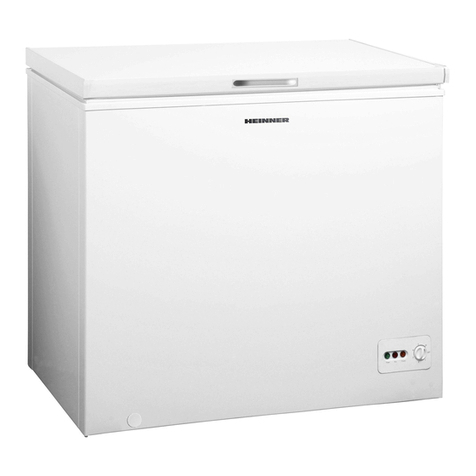
Heinner
Heinner HCF-249M manual
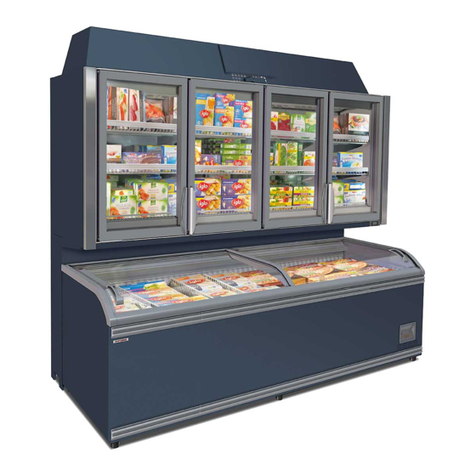
AHT
AHT Kinley Translation of the original operating manual

Thermo Scientific
Thermo Scientific ULT-10140-9-D Installation and operation
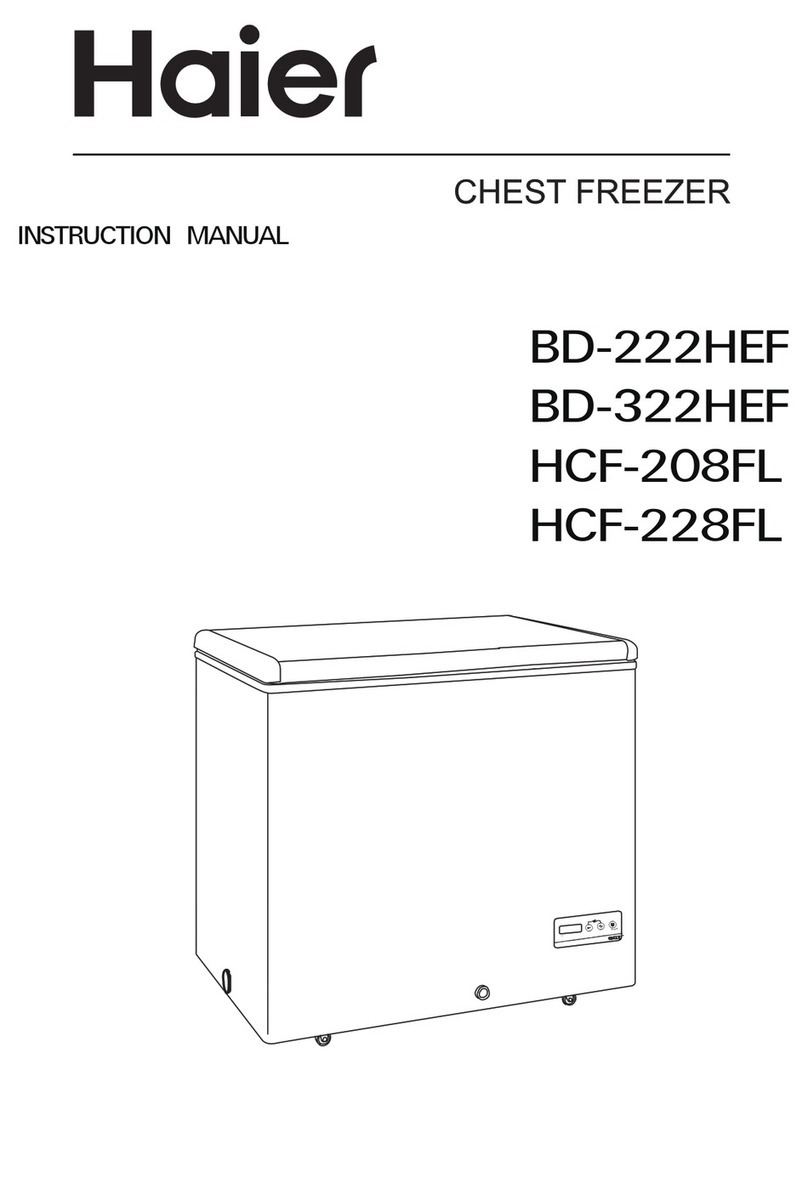
Haier
Haier BD-222HEF instruction manual
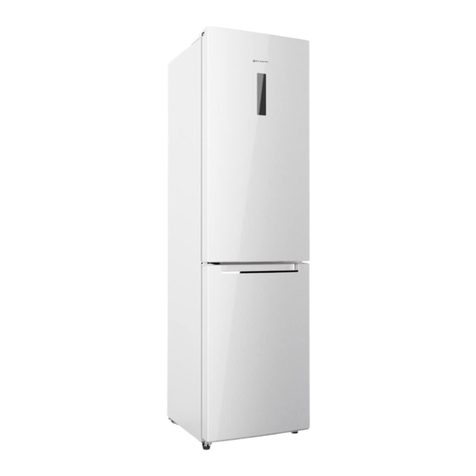
EAS Electric
EAS Electric EMC2020SW instruction manual

Whirlpool
Whirlpool WHM 3111 instruction manual


